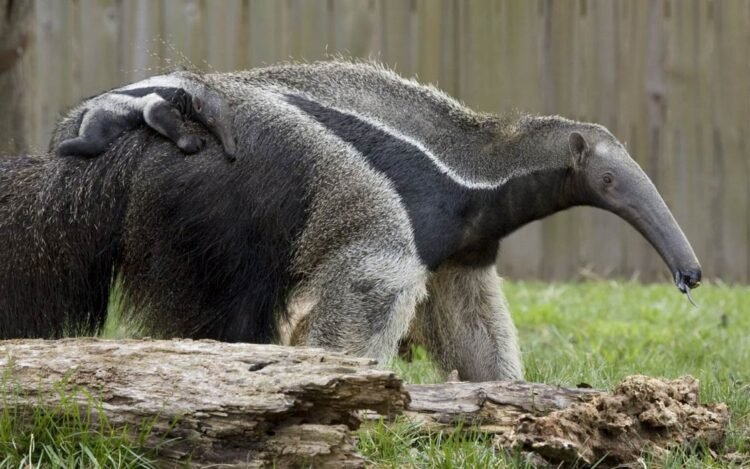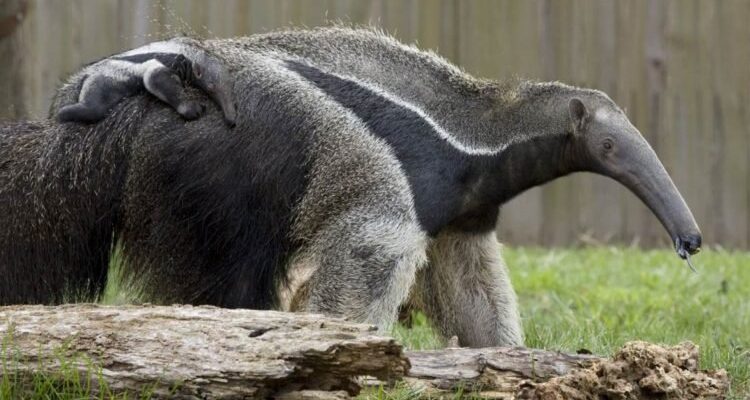
In this article, we’ll explore 10 animals that share characteristics with the giant anteater. You might be surprised by how some of them relate to our long-snouted friend! We’ll look at what makes each species unique and point out how you can tell them apart. So, grab your coffee, and let’s dig into the world of these intriguing creatures!
1. Other Anteater Species
Southern Anteater
The southern anteater, or Tamarino, is like the little brother of the giant anteater. It’s much smaller, topping out around 3 feet in length compared to the giant anteater’s impressive size. One of the easiest ways to tell them apart is by their size and habitat. While giant anteaters roam grasslands and savannas, southern anteaters prefer the dense forests of South America. They also have a more furry appearance, and their snouts aren’t quite as elongated, making them cuter and a bit more approachable.
Silky Anteater
Next up is the silky anteater, which is even smaller than its siblings, measuring only about a foot long. Imagine a tiny ball of fur with a long nose—that’s the silky anteater! You can recognize it by its silky, soft coat and a habit of hoisting itself up in trees. Unlike giant anteaters that stomp on the ground, these little guys are masters of the treetops, feasting on insects and fruits. If you spot one, take a moment to admire its delicate features.
2. Armadillos
Nine-Banded Armadillo
Armadillos and anteaters might seem worlds apart, but they share a fascination with burrowing and a taste for insects. The nine-banded armadillo is a standout example. With its tough, armor-like shell, it offers a stark contrast to the giant anteater’s sleek body. However, both have a keen sense of smell and dig through the earth to find food. The armored shell is the defining feature that sets the armadillo apart—no other animal has a similar protective exterior.
Giant Armadillo
The giant armadillo is another intriguing cousin. Just as the giant anteater towers over its relatives, this armadillo can reach lengths of about 3 feet. These creatures are nocturnal and prefer to live in underground burrows, unlike the mostly daytime habits of the anteater. Their distinctive feature? A long, pointed snout and those unique, segmented shells—definitely a different vibe compared to the sleekness of the giant anteater!
3. Pangolins
Ground Pangolin
You might be wondering, “What’s a pangolin?” These fascinating creatures are often called scaly anteaters and share a diet similar to that of the giant anteater—primarily ants and termites. The ground pangolin has a unique, armor-like body covered in scales, making it visually distinct from the fur-covered anteater. When threatened, it rolls into a ball, whereas giant anteaters rely on their size and strength. If you see a pangolin, you’ll notice its claws are also much more pronounced, used for digging into ant mounds.
Tree Pangolin
The tree pangolin, on the other hand, is a bit more agile. Unlike giant anteaters, which are primarily terrestrial, tree pangolins are adept climbers. Their long, curved claws help them grip branches while searching for food. The difference in habitat and climbing ability is a key way to distinguish them from the grounded giant anteater.
4. Sloths
Two-Toed Sloth
Sloths are another group that shares some habitat with the giant anteater, particularly in South America. A two-toed sloth is particularly notable for its slow movements and hanging lifestyle. They may both spend time in trees, but sloths are almost entirely herbivorous, munching on leaves rather than insects. The stark contrast between their diets, and the sloth’s slower lifestyle compared to the anteater’s hunting techniques, makes these two easily distinguishable.
Three-Toed Sloth
The three-toed sloth is similar to its two-toed counterpart, but it’s got the extra toe and a more varied diet that includes fruits. Both sloths are known for their lethargic pace, but their lifestyle in trees, along with their distinct features like a flat face, sets them apart from the giant anteater, who is all about that elongated snout and sleek body for taking on the ground.
5. Aardvarks
Aardvarks are often compared to giant anteaters due to their shared love for insects, especially ants. These creatures are native to Africa and are easily distinguishable by their pig-like snouts and large ears. The way an aardvark digs is also quite different; it uses its powerful claws to create burrows that are both homes and food sources. Aardvarks are typically more robust and are built for strength, while giant anteaters are leaner and more graceful.
6. Echidnas
Echidnas, or spiny anteaters, are another fascinating connection. While they look different on the outside, echidnas share the anteater’s desire for ants and termites. Their spiny coats protect them from predators, making them a unique family member within the anteater group. The key difference is that echidnas are monotremes, meaning they lay eggs, which sets them apart from giant anteaters that give birth to live young.
7. Tasmanian Numbat
The Tasmanian numbat is a small marsupial that primarily feeds on termites, much like the giant anteater. They’re known for their striking stripes and smaller size. While both creatures share a diet, the numbat is more agile and spends much of its time foraging in trees. Its vibrant markings and size make it stand out in comparison to the more massive and elongated giant anteater.
8. Coatis
You might find it curious that coatis share a similar habitat with giant anteaters. They’re members of the raccoon family, and their long snouts and flexible tails help them forage for insects and fruits. Although they are more social and often found in groups, their resemblance lies in their foraging habits. However, coatis have a much more playful demeanor, darting around trees and underbrush, while giant anteaters take their time, focused on finding their next meal.
9. Capybaras
Lastly, let’s talk about capybaras. While they’re herbivores, their squat, elongated bodies and social habits bear a resemblance to giant anteaters in terms of size. Capybaras are often spotted lounging near waterways, enjoying a different set of snacks, primarily grasses and aquatic plants. The primary difference, aside from diet, is that capybaras are highly social animals, often found in groups, unlike the solitary giant anteater.
10. Hedgehogs
Although they are not from the same habitat or family, hedgehogs may remind you of giant anteaters. They share some features, like their insect-eating habits. Hedgehogs curl up into a ball for protection, while anteaters stand their ground, confident in their size. It’s interesting to see how different animals evolve similar eating habits while taking completely different paths in their physical features and behaviors.
In the end, while the giant anteater is a unique creature, you can see that nature has crafted various animals that share some similarities. From their dietary preferences to their habitats, each of these animals tells a story worth knowing. Next time you see a giant anteater—or any of its relatives—take a moment to appreciate the variety of adaptations and differences that make each one special.

